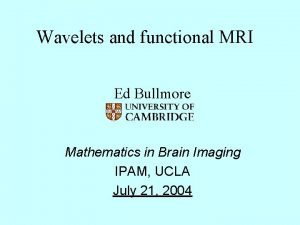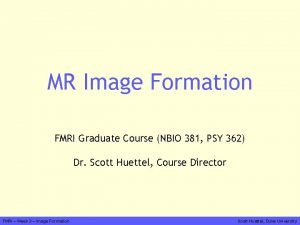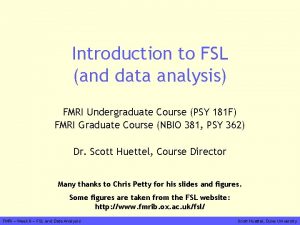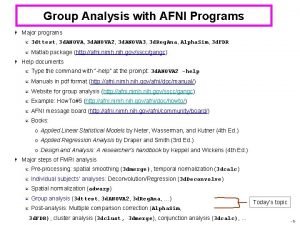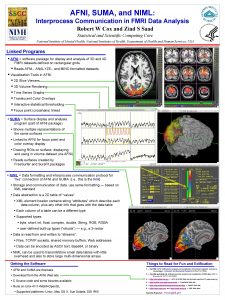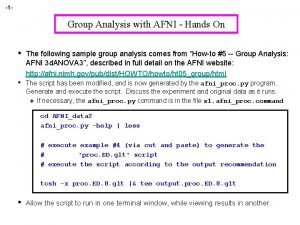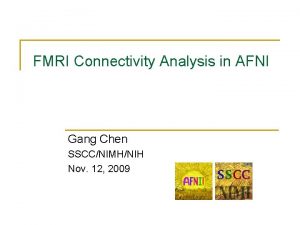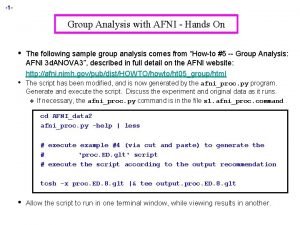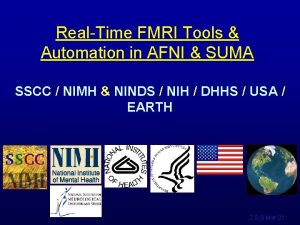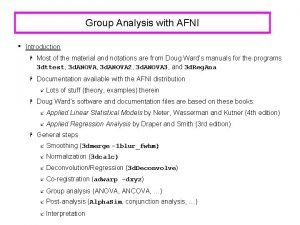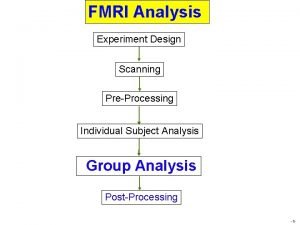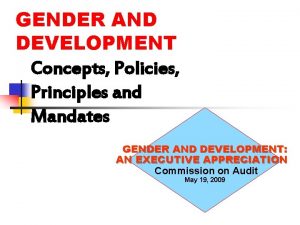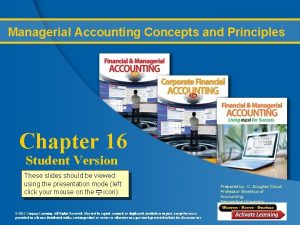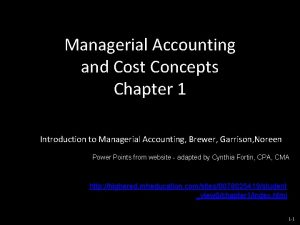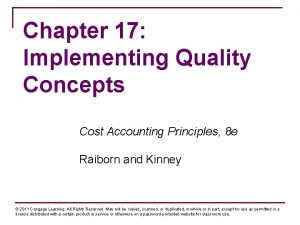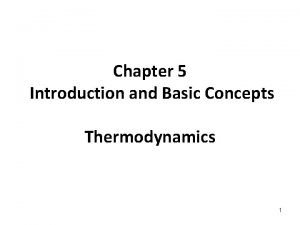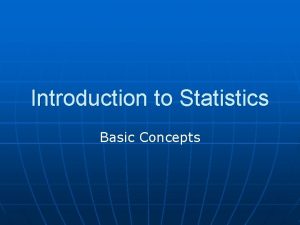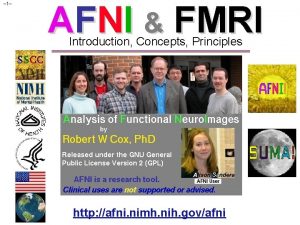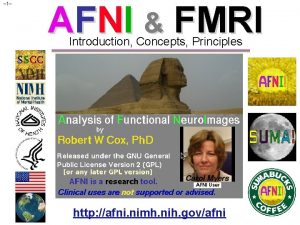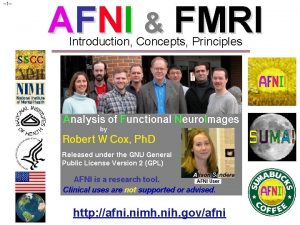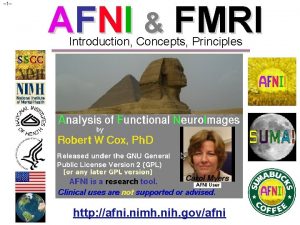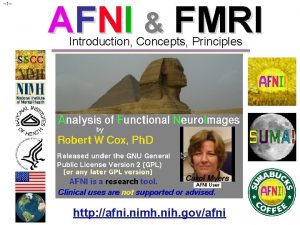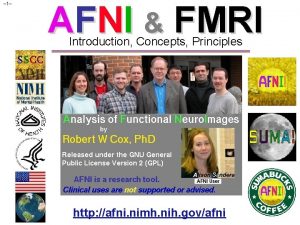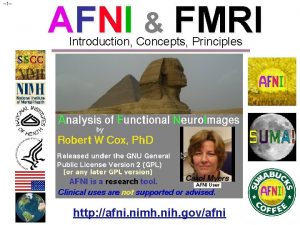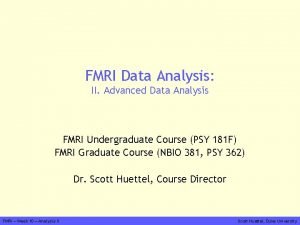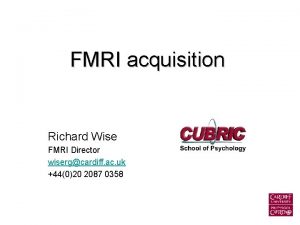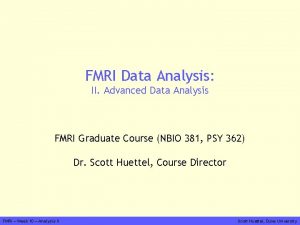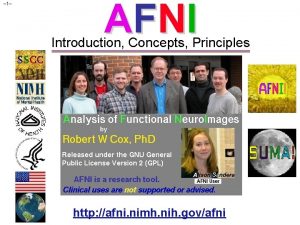1 AFNI FMRI Introduction Concepts Principles http afni
























- Slides: 24

– 1– AFNI & FMRI Introduction, Concepts, Principles http: //afni. nimh. nih. gov/afni

– 2– AFNI = Analysis of Functional Neuro. Images • Developed to provide an environment for FMRI data analyses And a platform for development of new software • AFNI refers to both the program of that name and the entire package of external programs and plugins (more than 200) • Important principles in the development of AFNI: § Allow user to stay close to the data and view it in many different ways § Give users the power to assemble pieces in different ways to make customized analyses o “With great power comes great responsibility” — to understand the analyses and the tools § “Provide mechanism, not policy” § Allow other programmers to add features that can interact with the rest of the package §

– 3– Principles (and Caveats) We* Live By • Fix significant bugs as soon as possible But, we define “significant” Nothing is secret or hidden (AFNI is open source) § But, possibly not very well documented or advertised Release early and often § All users are beta-testers for life Help the user (message board; consulting with NIH users) § Until our patience expires Try to anticipate users’ future needs § What we think you will need may not be what you actually end up needing § • • *

– 4– Before We Really Start • AFNI has many programs and they have many options • Assembling the programs to do something useful and good seems confusing (OK, is confusing) when you start • To help overcome this problem, we have 2 “super-scripts” that carry out important tasks § Each script runs multiple AFNI programs § We recommend using these as the basis for FMRI work o When you need help, it will make things simpler for us and for you if you are using these scripts • afni_proc. py = Single subject FMRI pre-processing and time series analysis for functional activation • align_epi_anat. py = Image alignment (registration), including anatomical-EPI, anatomical-anatomical, EPI-EPI, and alignment to atlas space (Talairach/MNI) • In the future: Graphical interfaces? Group analysis script?

– 18– • • How FMRI Experiments Are Done Alternate subject’s neural state between 2 (or more) conditions using sensory stimuli, tasks to perform, . . . § Can only measure relative signals, so must look for changes in the signal between the conditions Acquire MR images repeatedly during this process Search for voxels whose NMR signal time series (up-anddown) matches the stimulus time series pattern (on-and-off) § FMRI data analysis is basically pattern matching in time Signal changes due to neural activity are small • Need 1000 or so images in time series (in each slice) takes an hour or so to get reliable activation maps • Must break image acquisition into shorter “runs” to give the subject and scanner some break time • • Other small effects can corrupt the results postprocess the data to reduce these effects & be careful Lengthy computations for image recon and temporal pattern matching data analysis usually done offline

– 27– Fundamental AFNI Concepts • Basic unit of data in AFNI is the dataset § A collection of 1 or more 3 D arrays of numbers Each entry in the array is in a particular spatial location in a 3 D grid (a voxel = 3 D pixel) o Image datasets: each array holds a collection of slices from the scanner § Each number is the signal intensity for that particular voxel o Derived datasets: each number is computed from other dataset(s) § e. g. , each voxel value is a t-statistic reporting “activation” significance from an FMRI time series dataset, for that voxel o § Each 3 D array in a dataset is called a sub-brick o There is one number in each voxel in each sub-brick 3 x 3 x 3 Dataset With 4 Sub-bricks

– 28– Quick Sample of AFNI: Analysis • Script to analyze one imaging run (5 min) of data from one subject [ cd AFNI_data 6/afni ; tcsh quick. s 1. afni_proc ] afni_proc. py -dsets epi_r 1+orig -copy_anat+orig -tcat_remove_first_trs 2 -do_block align -regress_stim_times quick. r 1_times. txt -regress_basis 'BLOCK(20, 1)' -execute • Stimulus timing in file quick. r 1_times. txt 0 30 60 90 120 150 180 210 240 270 20 s of stimulus per block, starting at the given times • FMRI data in file epi_r 1+orig § Anatomical volume in file anat+orig • Actions: Align slices in time; align Anat to EPI; motion correct EPI; blur in space; activation analysis (thru time) in each voxel §

– 29– Quick Sample of AFNI: Viewing Results Fit of activation pattern to data Colorized+thresholded activation magnitudes

– 31– What's in a Dataset: Header • Besides the voxel numerical values, a dataset also contains auxiliary information, including (some of which is optional): § xyz dimensions of each voxel (in mm) § Orientation of dataset axes; for example, x-axis=R-L, y-axis=A-P, z-axis=I-S axial slices (we call this orientation “RAI”) § Location of dataset in scanner coordinates o o § Time between sub-bricks, for 3 D+time datasets o § Needed to overlay one dataset onto another Very important to get right in FMRI, since we deal with many datasets Such datasets are the basic unit of FMRI data (one per imaging run) Statistical parameters associated with each sub-brick o o e. g. , a t-statistic sub-brick has degrees-of-freedom parameter stored e. g. , an F-statistic sub-brick has 2 DOF parameters stored

– 32– AFNI Dataset Files - 1 • AFNI formatted datasets are stored in 2 files The. HEAD file holds all the auxiliary information § The. BRIK file holds all the numbers in all the sub-bricks Datasets can be in one of 3 coordinate systems (AKA views) § Original data or +orig view: from the scanner § AC-PC aligned or +acpc view: § • o § Dataset rotated/shifted so that the anterior commissure and posterior commissure are horizontal (y-axis), the AC is at (x, y, z)=(0, 0, 0), and the hemispheric fissure is vertical (z-axis) Talairach or +tlrc view: Dataset has also been rescaled to conform to the Talairach. Tournoux atlas dimensions (R-L=136 mm; A-P=172 mm; I-S=116 mm) o AKA Talairach or Stererotaxic coordinates o Not quite the same as MNI coordinates, but very close o

– 33– AFNI Dataset Files - 2 • AFNI dataset filenames consist of 3 parts The user-selected prefix (almost anything) § The view (one of +orig, +acpc, or +tlrc) § The suffix (one of. HEAD or. BRIK) § Example: Bill. Gates+tlrc. HEAD and Bill. Gates+tlrc. BRIK § When creating a dataset with an AFNI program, you supply the prefix; the program supplies the rest AFNI programs can read datasets stored in several formats § ANALYZE (. hdr/. img file pairs); i. e. , from SPM, FSL § MINC-1 (. mnc); i. e. , from mnitools § CTF (. mri, . svl) MEG analysis volumes § ASCII text (. 1 D) — numbers arranged into columns § Have conversion programs to write out MINC-1, ANALYZE, ASCII, and NIf. TI-1. 1 files from AFNI datasets, if desired § •

– 34– NIf. TI Dataset Files • NIf. TI-1. 1 (. nii or. nii. gz) is a new standard format that AFNI, SPM, FSL, Brain. Voyager, et al. , have agreed upon § Adaptation and extension of the old ANALYZE 7. 5 format § Goal: easier interoperability of tools from various packages • All data is stored in 1 file (cf. http: //nifti. nimh. nih. gov/) § 348 byte header (extensions allowed; AFNI uses this feature) § Followed by the image numerical values § Allows 1 D– 5 D datasets of diverse numerical types §. nii. gz suffix means file is compressed (with gzip) • AFNI now reads and writes NIf. TI-1. 1 formatted datasets § To write: when you give the prefix for the output filename, end it in “. nii” or “. nii. gz”, and all AFNI programs will automatically write NIf. TI-1. 1 format instead of. HEAD/. BRIK § To read: just give the full filename ending in “. nii” or “. nii. gz”

– 36– Getting and Installing AFNI • AFNI runs on Unix systems: Linux, Sun, Mac OS X § Can run under Windows with Cygwin Unix emulator o This option is really just for trying it out — not for production use! • If you are at the NIH: SSCC can install AFNI and update it on your system(s) § You must give us an account with ssh access • You can download precompiled binaries from our Website § http: //afni. nimh. nih. gov/afni § Also: documentation, message board, humor, data, … • You can download source code and compile it • AFNI is updated fairly frequently, so it is important to update occasionally § We can’t help you with old versions!

– 37– AFNI at the NIH Scanners • AFNI can take 2 D images in “realtime” from an external program and assemble them into 3 D+time datasets slice-byslice • Jerzy Bodurka (FMRIF) has set up the GE Excite-based scanners (3 Ts, 1. 5 T, and 7 T) to start AFNI automagically when scanning, and send reconstructed images over as soon as they are available: § For immediate display (images and graphs of time series) § Plus: Plus graphs of estimated subject head movement • Goal is to let you see image data as they are acquired, so that if there any big problems, you can fix them right away § Sample problem: someone typed in the imaging field-ofview (FOV) size wrong (240 cm instead of 24 cm), and so got garbage data, but only realized this too late (after scanning 8 subjects this way) — D’oh!

– 45– Other Parts of AFNI • Batch mode programs and scripts Are run by typing commands directly to computer, or by putting commands into a text file (script) and later executing them Good points about batch mode § Can process new datasets exactly the same as old ones § Can link together a sequence of programs to make a customized analysis (a personalized pipeline) § Some analyses take a long time (are not interactive) Bad points about batch mode § Learning curve is “all at once” rather than gradual § If you are, like, under age 35, you may not know how to, like, type commands into a computer to make it do things § • • o But we don’t make you use punched cards or paper tape (yet)

– 46– AFNI Batch Programs • Many many important capabilities in AFNI are only available in batch programs § A few examples (of more than 100, from trivial to complex) • 3 d. Deconvolve + 3 d. REMLfit = multiple linear regression on 3 D+time datasets; fits each voxel’s time series to activation model, tests these fits for significance (3 d. NLfim = nonlinear fitting) • 3 dvolreg = 3 D+time dataset registration, to correct for small subject head movements, and for inter-day head positioning • 3 d. ANOVA + 3 d. LME = 1 -, 2 -, 3 -, and 4 - way ANOVA/LME layouts: combining & contrasting datasets in Talairach space • 3 dcalc = general purpose voxel-wise calculator (very useful) • 3 dsvm = SVM multi-voxel pattern analysis program • 3 dresample = re-orient and/or re-size dataset voxel grid • 3 d. Skull. Strip = remove “skull” from anatomical dataset • 3 d. DWIto. DT = compute diffusion tensor from DWI (nonlinearly)

– 47– AFNI Plugins • A plugin is an extension to AFNI that attaches itself to the interactive AFNI GUI § Not the same as a batch program (which runs by itself) § Offers a relatively easy way for a C programmer to add certain types of interactive functionality to AFNI • Draw Dataset = ROI drawing (draws numbers into voxels) • Render [new] = Volume renderer • Dataset#N = Lets you plot multiple 3 D+time datasets as overlays in an AFNI graph viewer (e. g. , fitted models over data) • 3 dsvm = Interactive version of SVM MVPA • RT Options = Controls the realtime image acquisition capabilities of AFNI (e. g. , graphing, registration) • Plugout: a separate program that sends commands to AFNI to drive the display (sample scripts given in a later talk)

– 48– SUMA, et alii • SUMA is the AFNI surface mapper § For displaying surface models of cortex o Surfaces from Free. Surfer (MGH) or Caret (Wash U) or Brain. Voyager (Brain Innovation) Can display functional activations mapped from 3 D volumes to the cortical surface § Can draw ROIs directly on the cortical surface § o vs. AFNI: ROIs are drawn into the 3 D volume • SUMA is a separate program from AFNI, but can “talk” with AFNI (like a plugout) so that volume & surface viewing are linked § Click in AFNI or SUMA to change focus point, and the other program jumps to that location at the same time § Functional (color) overlay in AFNI can be sent to SUMA for simultaneous display • And much more — stayed tuned for the SUMA talks to come!

– 50– FMRI Experiment Design and Analysis All on one • All on one FMRI experiment design unreadable slide! § Event-related, block, hybrid event-block? [next slide] § How many types of stimuli? How many of each type? Timing (intra- & inter-stim)? § Will experiment show what you are looking for? (Hint: bench tests) § How many subjects do you need? (Hint: the answer does not have 1 digit) • Time series data analysis (individual subjects) § Assembly of images into AFNI datasets; Visual & automated checks for bad data § Registration of time series images (AKA motion correction) § Smoothing & masking of images; Baseline normalization; Censoring bad data § Catenation into one big dataset § Fit statistical model of stimulus timing+hemodynamic response to time series data o Fixed-shape or variable-shape response models § Segregation into differentially activated blobs (i. e. , what got turned on – or off? ) o Threshold on statistic + clustering and/or Anatomically-defined ROI analysis § Visual examination of maps and fitted time series for validity and meaning Group analysis (inter-subject) § Spatial normalization to Talairach-Tournoux atlas (or something like it; e. g. , MNI) § Smoothing of fitted parameters o Automatic global smoothing + voxel-wise analysis or ROI averaging § ANOVA+ to combine and contrast activation magnitudes from the various subjects § Visual examination of results (usually followed by confusion) § Write paper, argue w/ boss, submit paper, argue w/ referees, publish paper, … •

– 51– 3 Classes of FMRI Experiments Block Design: long duration activity Task / Stimulus Duration 10 s time Event-Related Design: short duration activity time Hybrid Block-Event Design Condition #1 Condition #2 time

– 52– FMRI Experiment Design - 1 • Hemodynamic (FMRI) response § § § peak is 4 -6 s after neural activation width is 4 -5 s for very brief (< 1 s) activation two separate activations less than 12 -15 s apart will have their responses overlap and add up (approximately — more on this in a later talk!) • Block design experiments: Extended activation, or multiple closely-spaced (< 2 -3 s) activations § § Multiple FMRI responses overlap and add up to something more impressive than a single brief blip (as in the picture above) But can’t distinguish distinct but closely-spaced activations; example: o o Each brief activation is “subject sees a face for 1 s, presses button #1 if male, #2 if female” and faces come in every 2 s for a 20 s block, then 20 s of “rest”, then a new faces block, etc. What to do about trials where the subject makes a mistake? These are presumably neurally different than correct trials, but there is no way to separate out the activations when the hemodynamics blurs so much in time.

– 53– FMRI Experiment Design - 2 • Therefore: Event-related designs: § § SLOW: Separate activations in time so can model the FMRI response from each separately, as needed (e. g. , subject mistakes) RAPID: Need to make inter-stimulus intervals vary (“jitter”) if there is any potential time overlap in their FMRI response curves; e. g. , if the events are closer than 12 -15 s in time o § Otherwise, the tail of event #x always overlaps the head of event #x+1 in the same way, and as a result the amplitude of the response in the tail of #x can’t be told from the response in the head of #x+1 Important note! o o o You cannot treat every single event as a distinct entity whose response amplitude is to be calculated separately! (OK, you can try, but …) You must still group events into classes, and assume that all events in the same class evoke the same response. § Approximate rule: 25+ events per class (with emphasis on the ‘+’) There is just too much noise in FMRI to be able to get an accurate activation map from a single event! § Caveat: you can analyze each event by itself, but then have to combine the many individual maps in some way to get any significance

– 54– FMRI Experiment Design - 3 • Hybrid Block/Event-related designs: § The long “blocks” are situations where you set up some continuing § § condition for the subject Within this condition, multiple distinct events are given and analyzed Example: o o Event stimulus is a picture of a face Block condition is instruction on what the subject is to do when he sees the face: § Condition A: press button #1 for male, #2 for female § Condition B: press button #1 if face is angry, #2 if face is happy Event stimuli in the two conditions may be identical, or at least fungible It is the instructional+attentional modulation between the two conditions that is the goal of such a study § Perhaps you have two groups of subjects (patients and controls) which respond differently in bench tests § You want to find some neural substrates for these differences § So you can tell an enthralling story and become wildly famous

– 57– Other Educational Presentations • How to get images into AFNI or NIf. TI format (program to 3 d) • Detailed hands-on with using AFNI for data viewing (fun) • Signal modeling & analysis: theory & hands-on (3 d. Deconvolve) • Image registration (3 dvolreg, et al. ) • Volume rendering hands-on (fun level=high) • ROI drawing hands-on (fun level=extreme) • Transformation to Talairach hands-on (fun level=low) • Group analysis: theory and hands-on (3 d. ANOVAx and beyond ) • Experiment design • FMRI analysis from start to end (the “soup to nuts” hands-on) • SUMA hands-on (fun level=pretty OK) • Surface-based analysis • AFNI “Jazzercise” (practice sessions & directed exercises)
 Afni fmri
Afni fmri Afni fmri
Afni fmri Resting fmri
Resting fmri Huettel fmri
Huettel fmri Fsl fmri
Fsl fmri Afni group analysis
Afni group analysis Suma afni
Suma afni Afni group analysis
Afni group analysis Sscc gang
Sscc gang Afni group analysis
Afni group analysis Afni dimon
Afni dimon Fft
Fft Does afni drug test
Does afni drug test Afni group analysis
Afni group analysis Http //mbs.meb.gov.tr/ http //www.alantercihleri.com
Http //mbs.meb.gov.tr/ http //www.alantercihleri.com Siat ung sistem informasi akademik
Siat ung sistem informasi akademik Gender and development principles
Gender and development principles Accounting principles and policies
Accounting principles and policies Accounting principles and concepts
Accounting principles and concepts Managerial accounting and cost concepts
Managerial accounting and cost concepts Quality principles and concepts
Quality principles and concepts Limiting factors example
Limiting factors example Introduction and basic concepts of thermodynamics
Introduction and basic concepts of thermodynamics Thermodynamics introduction and basic concepts
Thermodynamics introduction and basic concepts Introduction to statistics and some basic concepts
Introduction to statistics and some basic concepts


